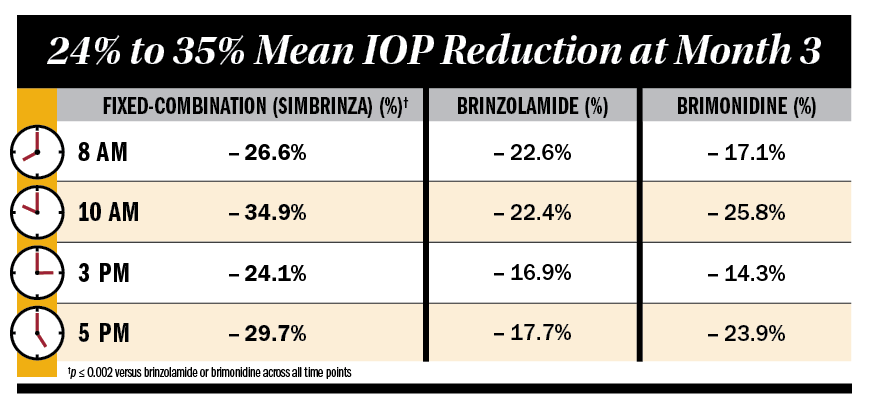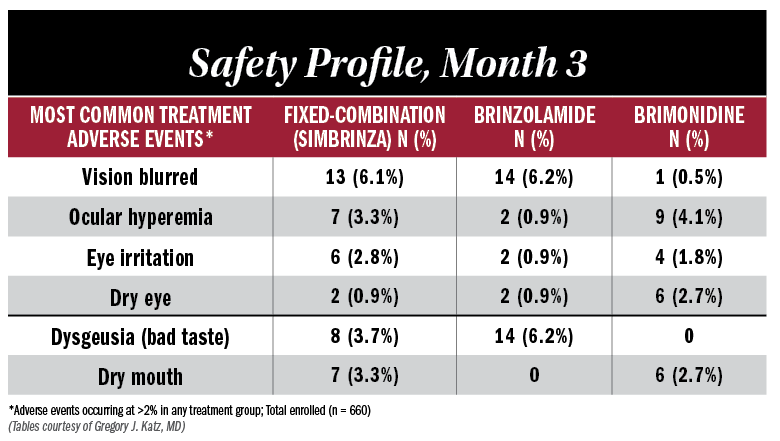Article
New glaucoma drug significantly lowers IOP
A new fixed-dose combination medication (Simbrinza, Alcon Laboratories) for the reduction of elevated IOP combines brinzolamide 1%, a carbonic anhydrase inhibitor, and brimonidine tartrate 0.2%, an alpha 2 adrenergic receptor agonist, in one multidose bottle. The drug is also the only available, fixed-dose combination therapy for glaucoma without a beta blocker in the United States, according to the manufacturer.
Take-Home
A new fixed-dose combination medication (Simbrinza, Alcon Laboratories) for the reduction of elevated IOP combines brinzolamide 1%, a carbonic anhydrase inhibitor, and brimonidine tartrate 0.2%, an alpha 2 adrenergic receptor agonist, in one multidose bottle. The drug is also the only available, fixed-dose combination therapy for glaucoma without a beta blocker in the United States, according to the manufacturer.

Basel, Switzerland-A new fixed-dose combination medication for the reduction of elevated IOP may provide patients with primary open-angle glaucoma or ocular hypertension with the best of two worlds.
The recent FDA approval of the fixed-dose combination medication (Simbrinza, Alcon Laboratories) combines brinzolamide 1%, a carbonic anhydrase inhibitor, and brimonidine tartrate 0.2%, an alpha 2 adrenergic receptor agonist, in one multidose bottle. The efficacy of the combination is superior to the effects of the two components administered separately.
In addition, it is the only available, fixed-dose combination therapy for glaucoma without a beta blocker in the United States, according to the manufacturer.

Dr. KatzGregory J. Katz, MD, a glaucoma specialist at St. Joseph Mercy Medical Center, Ann Arbor, MI, commented on the convenience that the combined dosing provides.
“Many patients with glaucoma end up needing more than one medication,” Dr. Katz said. “For example, nearly 40% of patients required two or more medications after 5 years in the Ocular Hypertension Treatment Study.
“Fixed combinations combine two active ingredients in one bottle,” he said. “This allows for administration of fewer drops in fewer bottles, less exposure to preservatives, and the elimination of the potential for washout effect, and it results in one co-payment compared with two co-payments for the patient.”
In addition, other fixed-combination glaucoma medications that are available contain a beta blocker, which has the potential to exacerbate congestive heart failure, asthma, and emphysema, as well as a variety of other medical conditions, he noted. One drop of the medication is instilled into the affected eye(s) three times daily.
Approval based on two trials
The FDA approval of the product was based on the results of two phase III multicenter studies, one of which was conducted by Dr. Katz and colleagues and included 660 patients with open-angle glaucoma or ocular hypertension. In this study, patients were randomly assigned 1:1:1 to treatment with the combination of brinzolamide 1% and brimonidine 0.2%, brinzolamide 1%, or brimonidine 0.2%. The patients instilled the drugs three times daily for 3 months.
The main outcome measure was the mean IOP at the 3-month evaluation at four time points (8 and 10 a.m. and 3 and 5 p.m.).
The investigators, who reported their findings (JAMA Ophthalmol. 2013;131:724-730), found that the mean IOP in the combined therapy group ranged from 16.3 to 19.8 mm Hg at the four time points. This range was significantly (p ≤ 0.002 and p < 0.001, respectively) lower compared with the results achieved when brinzolamide (19.3 to 20.9 mm Hg) and brimonidine (17.9 to 22.5 mm Hg) were administered separately.
“At all four time points, the brinzolamide-brimonidine group demonstrated the largest percentage reduction in IOP from baseline to the 3-month visit,” the investigators reported. “At 3 months, the brinzolamide-brimonidine group had IOP reductions ranging from 24.1% to 34.9% (across time points), the brinzolamide group IOP reductions ranged from 16.9% to 22.6%, and the brimonidine group reductions ranged from 14.3% to 25.8%.”

Thirty-four patients did not complete the study because of adverse effects that were not serious but related to the treatment. The most common of these were blurred vision, eye irritation, dysgeusia, dry mouth, and ocular allergy-all occuring in 6% or less of patients. There were no serious adverse events that were considered to be related to treatment in the combined treatment group. Most adverse effects were ocular in nature, and occurred in 22.9% of the combined-treatment group, 18.6% of the brinzolamide group, and 17.3% of the brimonidine group.
Use of the fixed-combination product has significant IOP-lowering capabilities when compared with either of the two drugs administered separately to treat open-angle glaucoma or ocular hypertension and has a safety profile that is consistent with those of the two components, the investigators concluded.
“Glaucoma must be treated over the patient’s life, and elevated eye pressure must be managed every day,” Dr. Katz said. “It’s exciting now to have a product available that combines two effective compounds in one multidose combination, offering sustained control with an excellent safety profile.”
Gregory J. Katz, MD
E: glbjkatz@hotmail.com
Dr. Katz is on the speaker’s bureau and is a consultant for Alcon Laboratories.
Subscribe to Ophthalmology Times to receive the latest clinical news and updates for ophthalmologists.
Newsletter
Don’t miss out—get Ophthalmology Times updates on the latest clinical advancements and expert interviews, straight to your inbox.




